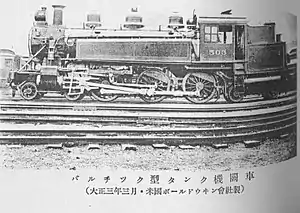Sentetsu Barui-class locomotive
The Barui class (バルイ) was a class of steam tank locomotives of the Chosen Government Railway (Sentetsu) with 4-6-4 wheel arrangement. The "Baru" name came from the American naming system for steam locomotives, under which locomotives with 4-6-4 wheel arrangement were called "Baltic".
| Chosen Government Railway Barui class (バルイ) Korean National RR Baru1 class (바루1) Korean State Railway Baruha class (바루하) | |||||||||||||||||||||||||||||||||||||||||||
|---|---|---|---|---|---|---|---|---|---|---|---|---|---|---|---|---|---|---|---|---|---|---|---|---|---|---|---|---|---|---|---|---|---|---|---|---|---|---|---|---|---|---|---|
 Sentetsu steam locomotive バルイ503 | |||||||||||||||||||||||||||||||||||||||||||
| |||||||||||||||||||||||||||||||||||||||||||
| |||||||||||||||||||||||||||||||||||||||||||
| |||||||||||||||||||||||||||||||||||||||||||
| |||||||||||||||||||||||||||||||||||||||||||
To meet the needs of ever-increasing freight traffic, four were built by the Baldwin Locomotive Works of the United States for Sentetsu in 1913,[1] who used them primarily on the Gyeongwon Line.[2] Another two were built in 1914, and subsequently a further six were added, and a total of twelve were in service at the time of Japan's defeat in the Pacific War in 1945.[1]
Initially numbered バルイ501 through バルイ512, they received the バルイ1 through バルイ12 numbers in Sentetsu's general renumbering of 1938.
After the partition of Korea, three went to the Korean National Railroad in South Korea, where they were called 발틱1 (or 발틱) class (Baltik), and nine to the Korean State Railway in North Korea, where they were designated 바루하 class (Paruha).[3]
References
- "バルチック型タンク機関車". Archived from the original on 2017-08-26.
- Byeon, Seong-u (1999). 한국철도차량 100년사 [Korean Railways Rolling Stock Centennial] (in Korean). Seoul: Korea Rolling Stock Technical Corp.
- "North and South Korea Steam Locomotives". 20 April 2004. Archived from the original on 20 April 2004.CS1 maint: bot: original URL status unknown (link)